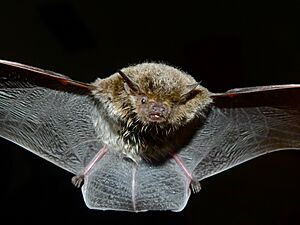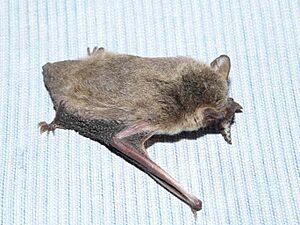Cape serotine facts for kids
Quick facts for kids Cape Serotine |
|
|---|---|
 |
|
 |
|
| Conservation status | |
| Scientific classification | |
| Genus: |
Laephotis
|
| Species: |
capensis
|
| Synonyms | |
|
Eptesicus capensis (A. Smith, 1829) |
|
The Cape serotine (Laephotis capensis) is a small bat found across a large part of Sub-Saharan Africa. The name 'serotine' means 'of the evening', which is fitting because these bats become active around sunset.
These tiny bats live in many countries. You can find them in Angola, Benin, Botswana, Burundi, Cameroon, Central African Republic, Republic of the Congo, Democratic Republic of the Congo, Ivory Coast, Equatorial Guinea, Eritrea, Eswatini, Ethiopia, Gabon, Ghana, Guinea, Guinea-Bissau, Kenya, Lesotho, Liberia, Malawi, Mozambique, Namibia, Nigeria, Sierra Leone, Somalia, South Africa, Sudan, Tanzania, Togo, Uganda, Zambia, and Zimbabwe.
Contents
About the Cape Serotine Bat
Where They Live
Cape serotine bats live in many different places. Their natural habitats include dry or moist tropical forests. They also live in dry savannas and moist savanna areas. You can find them in grasslands, bushveld, and Acacia woodlands too. While they can live in drier spots, they do not live in true desert regions.
What They Look Like
These bats are small and brownish in color. Their belly is usually greyish. Their fur can look a bit messy. The exact color of their fur can change depending on where they live. They have a small snout and mouth. Their forehead is shaped like a dome. Their wing membranes are dark. The forearm, which is part of their wing, is about 29 to 38 millimeters long. They weigh between 4 and 10 grams. When they fly to find food, they often look like they are playing!
Bat Homes and Habits
Cape serotine bats usually live in small groups. These groups can have up to about 20 bats. They like to roost (rest) in different places. They might hide under the bark of trees or inside hollow trees. Cracks in walls are also good spots. You can often find them under the eaves or roofs of houses. This includes houses with thatch, tiles, or corrugated iron roofs. Because they are quiet, people often don't even know they are there. They are also happy to live in a special bat house if you put one up!
Family Life and Food
Cape serotine bats have babies once a year. They usually give birth to 1 to 4 young bats. This happens between October and November. They eat many different kinds of flying insects. Their diet includes beetles, lacewings, moths, and mosquitoes. They also eat plant-sucking bugs and other flying insects.
Bats and Health
Scientists are learning more about bats and the tiny germs they can carry. Bats can carry many different types of viruses. Sometimes, these viruses can pass to other animals or even to humans. For example, some bats in Australia can pass a virus to horses. Then, horses can pass it to people.
It's important to remember that this is not a reason to harm bats. Bats are very helpful animals. They eat many insects, which is good for our environment. Experts usually advise people not to handle bats. This is because bats might carry germs. But we should still value them for all the good things they do for us.


